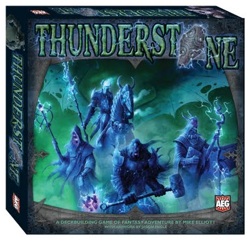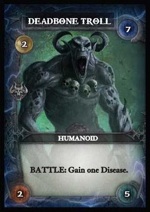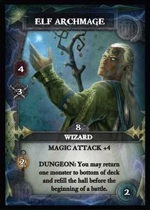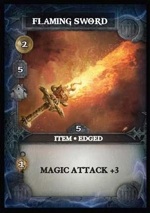
|
About OgreCave and its staff
|

|
by Lee Valentine
Thunderstone is one of Alderac Entertainment Group's newest card games. Like Alderac's Tomb product line, Thunderstone (TS) has a deep dungeon-delving theme. TS falls into the same category of game as Dominion – it's a game where you compete to collect cards to include in an ever-growing deck which you will continue to use throughout the rest of the game. TS's designer, Mike Elliott, has worked on a variety of collectible card and miniature games in the past, ranging from Heroclix to Hecatomb to the Harry Potter Trading Card Game. Alderac's Jim Pinto did some additional design work on the product line.
Mechanics: The Village A Dungeon deck is filled with 30 cards representing three randomly selected categories of monsters such as demons, dragons, or humanoids. In the lower third of the Dungeon deck is randomly inserted the Thunderstone, a card that is thematically the object of your quest, but is practically just a game ender card. Three Monsters are revealed and represent creatures roaming the first three levels or "Ranks" of the Dungeon. The Village is populated with four randomly selected character classes of adventurers or Heroes. You could have rogues, holy warriors, wizards, and rangers, for example. There are three levels of each class and multiple Heroes of every level. At the start of the game your reputation is low enough as a leader that you will only be able to recruit first level Heroes. As the game progresses the Heroes you recruit will gain experience and "level up", and you'll also be able to hire on higher level Heroes to your cause. The Village further contains some basic cards common to every game as well as eight total stacks of randomly selected equipment, weapons, spells, and hirelings that may help you on your quest to find the Thunderstone. Some of these help you gain advantage in the Dungeon, while some Villagers will help you wheel and deal in the Village itself. The game has an odd mechanic for purchasing things in the Village. While you don't usually sell your old items off to get new ones, many Village cards, and most Monsters that you defeat in the Dungeon, have a gold value of some kind printed on them. When you enter the Village you reveal all the cards in your hand with a gold value, generate a gold total, and you get to purchase one weapon, item, spell, or Hero. The new card and all the rest of your hand is discarded into a discard pile. When you run out of cards to draw from your Party Deck then you reshuffle your discard pile to start a new Party Deck. So your purchases in the Village become permanent additions to your ever-growing deck.
Mechanics: The Dungeon Most of your cards that don't generate Village-specific effects will either generate attack bonuses of some kind or will generate light in the dark Dungeon. Monsters have a health score (read "hit points"). If your attack score is equal to or greater than a given Monster's health, then you can kill it off. The Dungeon Deck is a giant monster conveyor belt, and as one Monster is defeated, all the other Monsters move forward to fill the gap, and a new monster fills in Rank 3 of the Dungeon. As a result, there're usually three Monsters to choose from at any one time.
One really interesting Dungeon mechanic is Light. The Monsters are well-adapted to fighting in the dark, but most of the Heroes aren't. The deeper in the Dungeon you travel, the darker it becomes, and the harder it is to see the monsters you are fighting. This translates into attack penalties which can be offset by carrying sufficient light-generating items into the Dungeon. I had a couple of problems, not with the idea of the mechanic, but with the way it was expressed in the game. The formula for the Light modifier is: ((amount of Light you produce + penalties - Dungeon Rank of the Monster) * 2), up to a maximum of +0. Since this formula has to be calculated for every monster in play, some of which are at different Dungeon Ranks or may have other custom Light modifiers, this can become a bit tedious. Rather than expressing the darkness as "Darkness", it is expressed as negative light, and you constantly have to multiply after summing, making this mechanic a bit more math-intensive than it should have been. A simpler mechanic could have been achieved by including Darkness counters with "-2" on them, adding and removing them from play as needed. Since I've made my own counters, game play has sped up substantially when it's my turn.
Mechanics: Purging Cards & Resting
Functionality Issues
TS's gameplay changes as you add more players. With fewer players it's pretty easy to access the cards you'll need cheaply, particularly Heroes. With more players, however, you can easily run out of Level 1 versions of Heroes, forcing you to buy more expensive, higher level characters. Competition over higher level heroes can also limit your ability to level up your own Heroes – a higher level card must be available to you before you can level up your character. The randomized setup can make some cards very useful for the current game, while others will be less useful. With more players there is much more competition over a scarce number of optimal cards, making the game more tense. With fewer players, the game is more of a multi-player solitaire. For example, in two-player play, most of the player-to-player interaction occurs in the Dungeon, based on which Monsters you choose to attack and which you'll leave for your opponent. In multi-player play, the mechanic of the Thunderstone card itself can randomly favor one or more players. When the Thunderstone reaches Rank 1 of the Dungeon, the game ends abruptly; the player with the most accumulated Victory Points in his Party Deck and discard pile wins. The randomization of the Thunderstone's location in the Dungeon Deck during setup means that it's possible for some players to get one more turn than other players. Since the a player can earn anywhere from 0 to 11 Victory Points on the last turn of the game in the Dungeon, the swing could occasionally be substantial.
Rulebook Clarity Alderac has tried to keep up with online rules questions by redrafting the rules multiple times since the game was released a few weeks ago. The current online edition of the rules fills in a lot of the gaps, but still is a bit rough around the edges, with a small handful of internal inconsistencies. Overall, TS has a very playable set of rules, but some parts are mildly convoluted. So, you have a choice of two rules sets – one which requires a fair bit of guesswork as to how the game works, but which will produce as good a game as you can tinker into existence, and another rules set which is more complex, more complete, and occasionally a bit rough around the edges. Whichever you choose, TS's gameplay is worth any struggles you might have with the rulebook. Much to their credit, Alderac's staff as well as gamer-volunteer Ryan Metzler, have been working around the clock since the game's release to bang the rulebook into shape. I recommend avoiding trying to visit online forums and looking into past answers to questions, as I am not sure that older answers are consistent with current rules. The game's rulebook wasn't fully baked when it was released, but now, a couple of weeks after release, it's closer to a finished product. Alderac has hinted that they may provide a revised printed rulebook in their first expansion, Thunderstone: Wrath of the Elements. So, if you are the kind of consumer that buys gaming expansions, the revised rulebook online may be worth a look, as it will likely to be closer to the forthcoming expansion rulebook.
Product Appearance & Component Quality
While TS cards are designed to segregate different types of information into different places on the cards, the numbers often appear over round, colored circles rather than evocative icons. As a result, if you can't remember the information based on pure position on the cards and color, then you are completely out of luck for understanding certain cards in TS, particularly Monsters. My wife's not a gamer geek, and I saw her eyes glaze over when I handed her a TS card – the lack of appropriate iconography would have been a major stumbling block if I had asked her to play, so I didn't bother. Gamer geeks are used to positionally identifying data, so this shouldn't be a problem for you if you are anything more than the occasional gamer. The cards themselves are noticeably thinner than other game cards, which is odd for a game which requires as much shuffling of small groups of cards as Thunderstone does. Alderac selected a black border on the cards which shows wear more than a white border would have.
Packaging The game includes 50 slightly oversized cards with Thunderstone logos on the front and back. At first, I thought these were the "Thunderstone" card referred to in the rulebook, since this stack of cards wasn't mentioned at all in the original rules. Only by asking a question in an online forum was I able to figure out what these "mystery cards" were. The box has an internal plastic tray which is designed to hold the normal game cards with these oversized cards as tabs or dividers. Since these 50 dividers have no labels on them like traditional tabbed indexes, and since the rulebook doesn't discuss storage at all, you are left to your own devices for figuring out a sorting and separation system that suits you. The product insert seems fairly sturdy as does the box the product comes in. The artwork on the box cover is beautiful, featuring a variety of the spectral monsters from Grimhold Dungeon and the TS logo itself. The box is impressive overall, but a good bit larger than it needed to be to store the cards. Perhaps extra space was built-in to allow for the inclusion of the upcoming expansion. For the time being, I've transferred over my cards to small gripseal bags for each type of card and put them in a smaller box.
Conclusions
Retailer Saleability Lee's Ratings
Overall: B+
Links
|
||||
 Thunderstone
Thunderstone Like Village purchases, defeated Monsters are added to the discard pile
of your Party Deck, becoming a regular part of your future draws. Most
Monsters generate long-term gold, but also generate experience (for
"leveling up" your Heroes into more powerful variants of their class).
Lastly, Monsters generate Victory Points. The player with the most
Victory Points at the end of the game wins. Since the majority of
Monsters don't help you in the Village or in future Dungeon combats,
victories become a self-limiting process; if you have a hand that's full
of previously killed Monsters you typically won't generate the necessary
resources to defeat other Monsters in the Dungeon. Since Monsters do
generate gold, you'll have to use the gold that they generate to buy
better and better cards in the Village to continue to guarantee that the
non-Monster cards you draw are sufficient to generate you a win in the
Dungeon.
Like Village purchases, defeated Monsters are added to the discard pile
of your Party Deck, becoming a regular part of your future draws. Most
Monsters generate long-term gold, but also generate experience (for
"leveling up" your Heroes into more powerful variants of their class).
Lastly, Monsters generate Victory Points. The player with the most
Victory Points at the end of the game wins. Since the majority of
Monsters don't help you in the Village or in future Dungeon combats,
victories become a self-limiting process; if you have a hand that's full
of previously killed Monsters you typically won't generate the necessary
resources to defeat other Monsters in the Dungeon. Since Monsters do
generate gold, you'll have to use the gold that they generate to buy
better and better cards in the Village to continue to guarantee that the
non-Monster cards you draw are sufficient to generate you a win in the
Dungeon.
 While TS advertises that it is playable with from 2-5 players,
the Alderac website features solo play rules as well (see the links
below). The game is highly playable as a solitaire game, but oddly
these rules were available only online and not as part of the product's
print edition rulebook.
While TS advertises that it is playable with from 2-5 players,
the Alderac website features solo play rules as well (see the links
below). The game is highly playable as a solitaire game, but oddly
these rules were available only online and not as part of the product's
print edition rulebook.
 The cards' trade dress looks very good as well, but the game suffers
from production decisions of form over function. Cards which are used
solely as pre-game randomizers have substantially similar appearance and
identical card backs as cards actually used in the game. I think that
was a mistake.
The cards' trade dress looks very good as well, but the game suffers
from production decisions of form over function. Cards which are used
solely as pre-game randomizers have substantially similar appearance and
identical card backs as cards actually used in the game. I think that
was a mistake.